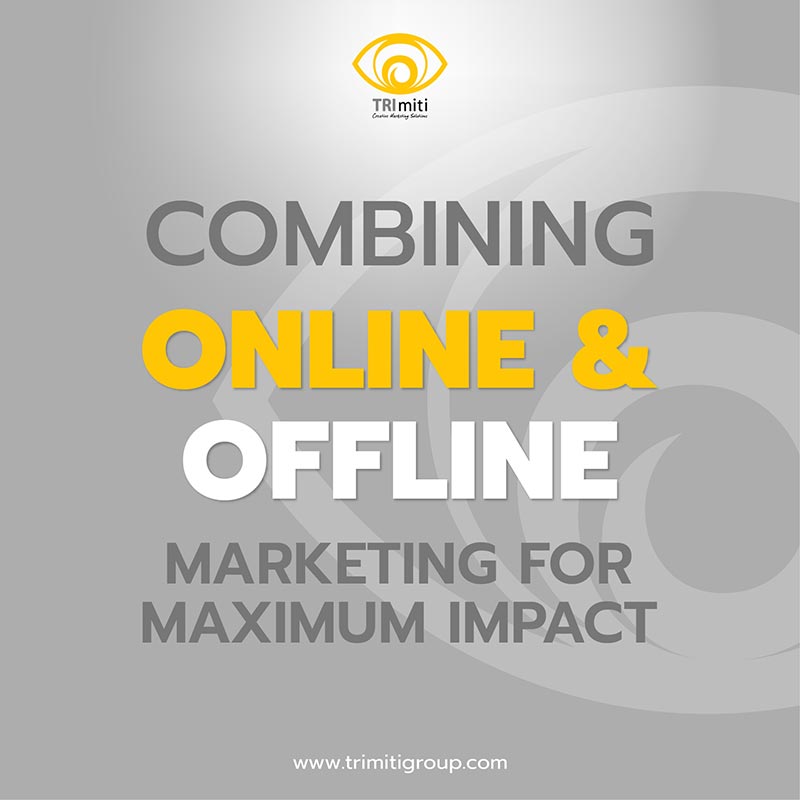
Combining Online and Offline Marketing for Maximum Impact
In today’s competitive market, integrating online and offline marketing strategies is essential for creating a seamless brand experience. This hybrid approach allows businesses to leverage the strengths of both channels, driving greater engagement, reach, and results. Here’s a breakdown of the importance, strategies, and benefits of combining online and offline marketing:
- Why Combine Online and Offline Marketing?
Enhanced Customer Reach- Online marketing expands your reach globally, while offline marketing ensures strong connections within local communities. Together, they create a comprehensive strategy that engages diverse audiences.
- A unified message across online and offline platforms reinforces brand identity, making your marketing efforts more memorable and credible.
- Combining tactile experiences (e.g., brochures or events) with digital convenience (e.g., QR codes or social media follow-ups) keeps customers engaged across multiple touchpoints.
- Online tools, such as analytics and tracking links, can measure the success of offline efforts, like direct mail campaigns, providing valuable insights for optimization.
- Strategies for Integrating Online and Offline Marketing
Use QR Codes to Bridge the Gap- QR codes on print materials, such as flyers, posters, or business cards, can drive traffic to websites, landing pages, or social media platforms.
- Example: A real estate flyer with a QR code linking to a virtual tour of a property.
- Promote offline events, like open houses, product launches, or community activities, through online channels like email marketing and social media.
- Example: Live-stream a grand opening event on Facebook to engage a broader audience.
- Encourage customers to share their offline experiences on social media using branded hashtags or check-ins.
- Example: A restaurant offering a discount to customers who post a picture of their meal with a specific hashtag.
- Use unique promo codes or tracking links in offline ads to monitor performance and conversion rates.
- Example: A magazine ad featuring a discount code valid only for online purchases.
- Combine direct mail campaigns with personalized email or SMS follow-ups for better engagement.
- Example: A mailer promoting a sale with a personalized URL (PURL) for exclusive online deals.
- Ensure consistent messaging, visuals, and tone across online and offline platforms.
- Example: A hotel’s print brochure should match the design and information on its website.
- QR codes on print materials, such as flyers, posters, or business cards, can drive traffic to websites, landing pages, or social media platforms.
- Benefits of Combining Online and Offline Marketing
Broader Audience Reach- While online marketing excels at reaching tech-savvy audiences, offline efforts connect with those less digitally inclined, ensuring no customer is left out.
- Offline experiences create tangible, memorable interactions, while online channels provide convenience and instant access to information.
- A cohesive strategy ensures that each channel supports the other, maximizing the return on investment.
- Tracking tools, like Google Analytics, combined with offline metrics (e.g., event attendance or coupon redemption), provide a holistic view of campaign performance.
- Practical Examples of Integration
Retail- Use in-store signage to encourage customers to follow your social media accounts or sign up for newsletters to access exclusive offers.
- Combine open house events with online promotions, such as live virtual tours and follow-up emails to attendees.
- Place QR codes on hotel room key cards to guide guests to online reviews, booking platforms, or social media pages.
- Include print inserts in shipped packages with calls-to-action like “Share your unboxing moment using #OurBrandName for a chance to win!”
- Actionable Tips
- Plan Your Campaign Holistically: Align goals and strategies for both online and offline channels from the start.
- Leverage Data: Use online data to refine offline efforts, such as targeting demographics for direct mail campaigns.
- Test and Optimize: Regularly assess the performance of integrated campaigns to identify strengths and areas for improvement.
Conclusion
Combining online and offline marketing is a powerful way to amplify your reach, engage customers, and create a cohesive brand experience. By leveraging the strengths of both channels and maintaining consistent messaging, businesses can achieve maximum impact and drive better results. Integrating these strategies ensures that your marketing efforts resonate with today’s multi-channel consumers.
Interested in Marketing? Contact TRImiti Group
Tel: +66(0)8 1477 8100
WhatsApp: +66(0)8 1538 9466
E-mail: info@trimitigroup.com
Website: www.trimitigroup.com
TRImiti BLOG
- Video Marketing Trends to Watch: Captivating Your Audience in 2025
- The Power of Visual Marketing: Why Stunning Graphics Matter for Your Brand
- Digital Marketing Strategies for Real Estate Success
- Combining Online and Offline Marketing for Maximum Impact
- Building a Brand Identity: Lessons from 17 Years of TRImiti Group
- Boosting Engagement with Interactive Social Media Campaigns
- เพิ่มการมองเห็นของคุณด้วย Google Business Profile – 10 ข้อดีที่คุณควรรู้
- What is Onlife Marketing?
- Onlife Marketing คืออะไร
- Think Print Marketing is Dead? Think Again!
- ปัจจัยที่ทำให้ Digital Marketing ประสบความสำเร็จ
- ทำธุรกิจ ทำไมต้องมี LINE OA
- 6 วิธีการสร้าง Personal Branding ให้เป็นที่รู้จักและจดจำ
-
คุณทำวิดีโอเพื่ออะไร
แล้วได้ผลจริงหรือ? -
ทริคสร้าง GOOGLE MY BUSINESS
พร้อมการปักหมุดง่ายๆ -
จะทำเว็บไซต์เลือก WORDPRESS
หรือเขียนเว็บไซต์ขึ้นใหม่ดีกว่า? -
5 เทรนด์ Customer Experience
ที่ธุรกิจควร จับตามองในปี 2021 - 7 เหตุผลที่ต้องพัฒนาแฟนเพจให้มีคุณภาพ
- 9 อาชีพ ที่ตลาดต้องการในปี 2021
- สถิติในการใช้ Social Media ของคนไทย ปี 2021
- 6 แนวคิดพื้นฐานก่อนออกแบบโลโก้
- ยอด Likes ใน Facebook อาจจะถูก "ยกเลิก" ในเร็วๆ นี้
- Facebook Pixel เครื่องมือทำการตลาดออนไลน์ ที่ขาดไม่ได้!